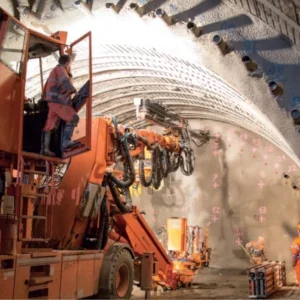In the future, we will continue to see the industry’s development towards increased performance and stricter quality demands in tunnelling. Regarding drill and blast, this will extend far beyond the traditional profile tolerances of the tunnel, to the total quality of the tunnel, care of the environment, vibration and noise from excavation.
The project requirements and tolerances require constant measurement, control and documentation from the contractor. The final target should be a continuous, cost-effective and accurate construction method under any conditions.
As long as the use of mechanised tunnelling is restricted only by rock hardness or tunnel geometry, there is a lot that can be done to improve the competitiveness of drill and blast tunnelling.
There is likely to be a continued cross-communication between the different stages of drill and blast that will ultimately lead to more multi-functional machines, decreasing the necessary set-up and waiting times in the cycle. The information that can already be collected from individual stages will be processed on-line so that subsequent stages can immediately take full advantage of the data available.
Information technology and automation will be a standard and widely accepted tool in the industry. Automation of the drilling process will also influence the development of the equipment and drill steels, making availability and service life more predictable. Furthermore, we will see longer rounds in tunnelling. Today 6m long round lengths are on the brink of becoming standard, and the limit for round lengths still seems a long way off as development of drilling units, tools and explosives progress.
The need for long-hole drilling in underground construction looks certain to increase as a result of the increased requirements on preventing water leakage. Systematic pre-grouting has today become routine in many countries. So far, the drilling of grout-holes is carried out with standard equipment with only slight modifications, and the performance of the work is not acceptable. Systems and tools that are more effective will become available for this demanding task.
Development of drilling performance
The introduction of hydraulics into face drilling equipment increased the power level and performance of drill jumbos to almost double of what was achieved with pneumatic units. The next step was to increase the output power and performance by taking benefit of advanced hydraulic and electric control systems to handle the essential drilling parameters. With sophisticated controls, power output level in drill steel can today be above 20kW with each rock drill.
Drilling machines have now developed to a level where actual drilling speed is no longer a bottleneck for performance. Increased drilling power has given substantially higher penetration rates; in Scandinavian granite the penetration rate has increased from 1.5m/min to 3m/min. The time taken to actually drill the hole is starting to have less importance for the whole round drilling time, as all other stages, like tramming, set-up of the rig, boom movement times, etc, are becoming more important.
Automation and instrumentation
The development of instrumentation and automation in face drilling started in the 80s. However, wide acceptance of the new systems did not happen until the 90s. Today, there are different levels of instruments and automation available for different requirements.
Simple angle indicating instruments typically show the look-out angle of the drill feed. The simplest of which show the direction in reference to the direction of the machine and/or the gravity field. The more advanced ones can be navigated to the direction of the round, thus giving true look-out angles for the holes in the round. The system typically shows the horizontal and vertical angle of the feed either numerically or graphically. In addition, other basic information about drilling is given by the measuring system; hole depth, drilling speed, etc.
Angle and position indicating systems can show both the angle and position of the feed rails. The drilling pattern is pre-programmed, and the operator can use the display as an aid to spot all holes accurately according to the plan. No marking-up of the face is needed before drilling the round, because of the pre-programmed drilling pattern and navigation to the tunnel reference line.
Fully computerised jumbos can operate automatically according to a pre-programmed drilling pattern. The automatics take care of the whole drilling cycle including all drilling functions, moving from one hole to another, drill hole adjustments, etc. The data control now allows a single operator to supervise simultaneous drilling with three booms, saving both considerable time, and expense on manpower. In fully computerised jumbos, the position and depth of each hole, as well as drilling sequence of each boom, has to be planned and pre-programmed into the drilling rig. Advanced data logging systems are integrated with a higher level of instrumentation of drill jumbos. This is available from either angle and position indicating systems like Tamrock‘s TCAD, or fully automatic control system TDATA. These systems typically collect data from the drilled rounds, such as: actual drilled position of each hole; amount of holes and drill metres; drilling times; and drilling parameters of the unit. The drilling parameters can be logged and reported as a function of hole depth.
For the drill and blast team, exact planning and pre-programming of the drill pattern, together with logged information about actual drilled pattern and drill parameters, offer excellent means to optimise the drill and blast design, to control the work and to exactly plan and realise charging and blasting of every round.
Development of drilling tools
The trend to increase drilling power and advance length combined with the increased requirements on precision, has, in turn, put tough requirements on the drill steels. The drill string is often the weakest part of the system, and increasing the power results in reduced life of the drill steels – not higher penetration rates as aimed. As a result of the more powerful hammers used today, the risk of premature failures, as well as excessive hole deviation, increases drastically.
Latest developments in drilling tools go some way towards minimising such short drill steel lifetimes by improved accuracy in collaring, better rigidity and straighter holes even with long rod lengths, and also in higher penetration rates with improved efficiency and flushing.
The process concept
Today’s strict contract requirements are hard to meet with traditional drill and blast equipment or methods. To carry out high-quality works effectively and economically, the latest equipment, tools and continuous improvement of the method are definitely needed.
To get the full benefits, the different stages of the drill and blast cycle cannot be considered separately. Each stage can affect the performance or cost of the other stages, and a slight change in time or money spent in one stage can result in a considerable opposite change in another. Careful optimisation of all the stages together is called The Process Concept in Tunnelling. The essential parts of this concept are:
Planning is the central function in the process and is essential to enable effective operation and should be open to rapid changes whenever feedback from any stage requires modifications. Planning is therefore continuous, based on measured and reported results.
The biggest advantages of instrumentation in modern drilling equipment are the machine’s ability to repeat the designed drilling plan round after round, and to produce information about drilling.
The repeat accuracy makes it possible to adjust the drilling plan according to the measured results of the profile or fragmentation, and to optimise the number and layout of drill holes in the pattern. The reporting functions can be used for finding ‘bottlenecks’ in the drilling cycle and for improving blasting in changing/varying rock conditions. Operators’ comments on the conditions are also essential for the charging crew. Charging and blasting should be planned in close co-operation with the programming of the drilling machines.
Mucking and hauling of the blasted rock provides information on rock fragmentation and the floor conditions of the round. This helps during the planning of rock reinforcement, a stage that has to be carried out in a defined way. However, it should be noted that both drilling and charging may drastically affect the reinforcement needed.
Surveying and profile measurement is another essential part of the complete drill and blast cycle. The accuracy of drilling fully depends on the accuracy of the information given to the drill jumbo. To be able to get the best possible quality tunnel, the profile of each round should be measured and the results immediately utilised in planning and performing the next round. Surveying also provides information on the exact advance of each round, making it possible to maximise the length of each subsequent round.
The process way of working requires both new tools and a modern mindset of the people on site. The ways to control and report the different stages of operation have to be defined, and the work should be carried out as a team effort of experienced professionals, where each team member feels the responsibility and capability of affecting the end result: a high quality tunnel excavation with the best possible performance at the lowest cost.






